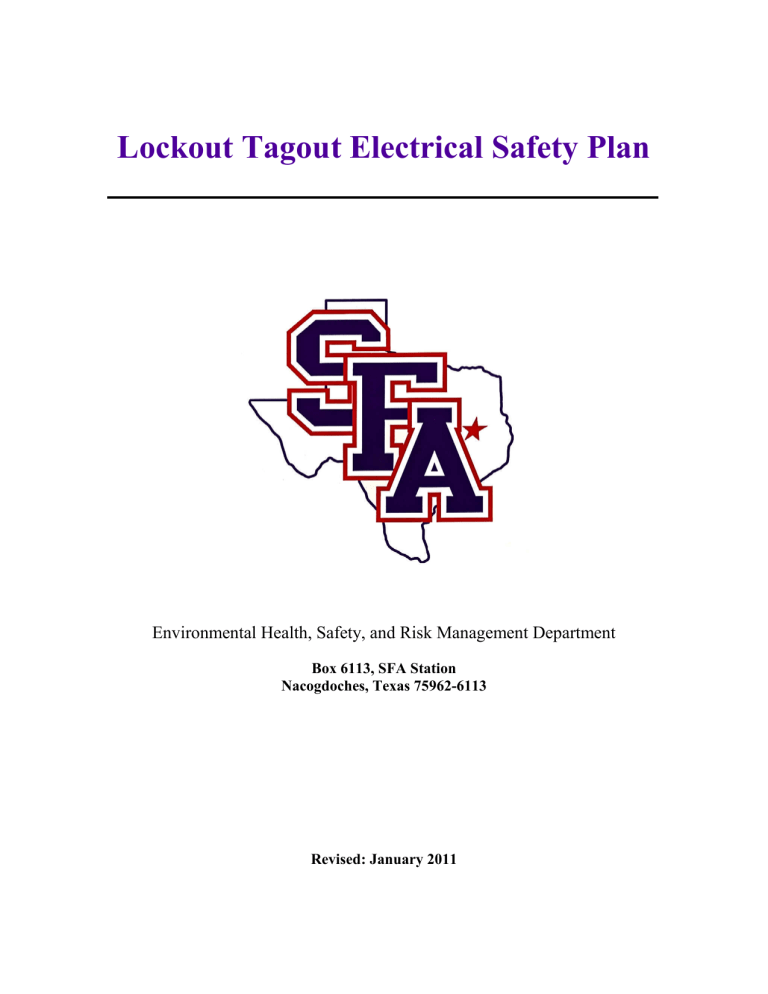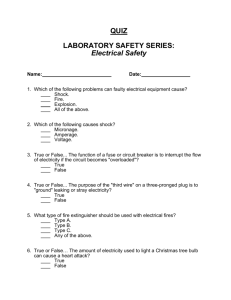Lockout Tagout Electrical Safety Plan Box 6113, SFA Station

Lockout Tagout Electrical Safety Plan
Environmental Health, Safety, and Risk Management Department
Box 6113, SFA Station
Nacogdoches, Texas 75962-6113
Revised: January 2011
LOCKOUT TAGOUT
The purpose of this program is to eliminate the accidental energizing of equipment, which could cause injury or death to employees, while performing maintenance on machines and equipment.
This program provides procedures that will be used by supervisors and the persons who perform electrical or mechanical work on various machines and equipment.
Experience has shown that the only positive method to protect repairmen from machine accidents is to lock the main machine power source in the off position. Machines also have, along with electricity, air, hydraulics, or mechanical means to power them. These areas must also be locked in a safe position.
PROCEDURE :
The following must be observed each time a piece of equipment is shut down for maintenance.
1.
Each Maintenance Person and Electrician will be supplied with a uniquely keyed lock. This lock will be placed on the main switch or breaker with the person doing the repair work maintaining possession of the key.
2.
Locked equipment must also be tagged out. Tags shall not replace locking out. The point-ofoperation switch would be the best place for the tag; but if this is not possible, place the tag where the machine operator can see it easily; also place the tag at the panel disconnect.
3.
Test the Locked-Out main breaker switch by trying to close the circuit breaker with the lock in place.
4.
Test the circuit to assure it is de-energized by closing the local switch to see whether the equipment starts. Then return the switch to the off position. If this is not possible, use the proper equipment to test the circuit.
5.
If more than one maintenance person is working on a piece of equipment, each should use their lock to cover the event that one worker has to leave.
6.
If the machine has air or hydraulic controls that would pose a danger to the work being done, these controls will be locked or tied in an off or zero-movement position. If they are in a place that they could be untied easily by an unknowing operator, a tag will be placed at the point they are tied.
7.
In the case of open panel, a tag should be placed on disconnect inside panel, and if machine is left alone for any reason, panel should be shut and locked out.
8.
At any time tags should not be removed by unauthorized persons. Only a maintenance person or maintenance supervisor upon completion of work may remove tags. Any violations of this policy will be subject to disciplinary action.
ROUTINE WORK :
Supervisors, employees, Contractors, etc., in some cases perform periodic cleaning and maintenance work on machines or equipment that could, if energized, cause injury. During operations where accidental starting of machines or equipment can cause injury, it will be necessary for the supervisor to lock out the equipment.
ENERGIZED MAINTENANCE :
In those situations where it is absolutely necessary to perform energized maintenance work, tags must be placed at all stations that could make the equipment active.
INCOMPLETE WORK :
In the case where work is not completed at the end of the work period or if the maintenance person is moved from the job before the work is complete, his personal lock must remain in place until the work is complete. The supervisor must be notified and the night maintenance person must be informed. At this time a decision must be made on how this lock out would affect the night maintenance work.
ELECTRICITY:
1.
Unless it is a part of your regular job, don't attempt to repair or adjust any electrical equipment.
2.
Treat all electric wires as live wires. DO NOT TOUCH DANGLING WIRES. Report them immediately.
3.
Ground wires leading from electrical apparatus must not be disconnected or broken.
4.
When working with electric portable tools, especially when in damp places, check the insulation or extension cords. Also wear rubber shoes.
5.
Disconnect electrical service to electrical driven machinery and tag as "maintenance being performed - do not operate"
6.
Before using an extension cord make sure there are no breaks in the insulation and that the plug socket and lamp guard are in good condition.
7.
Never use an extension cord in the place of permanent wiring.
8.
Voltages lower than 110 will cause death under certain conditions.
ELECTRICAL SAFETY
1.
All motors, fuse boxes, switch boxes, and other electrical equipment must be provided with a ground. (Except as noted in the National Electric Code NFPD-70).
2.
All equipment control switches must be easily accessible to the operator.
3.
Individual disconnect switches must be provided for each permanent machine.
4.
Temporary wiring will be installed only by authorized personnel. Such wiring must be replaced with permanent installations or removed within 90 days. See National Electric Code
NFPA-70.
5.
Only authorized personnel will repair and/or install electrical equipment.
6.
Until properly grounded or locked out; dead electrical circuits shall always be treated as live circuits.
7.
All electrical cabinets and enclosures must be kept clear of tools, clothing, rags and other material, i.e., unobstructed at all times.
8.
The makeup or use of an extension cords with a male connector at each end is prohibited.
9.
The use of extension cords in excess of their rated capacity is prohibited.
10.
Extension cords should be kept off the floor where possible, and the use of such wiring shall be held to an absolute minimum. Extension cords will not be run across passageways without protection. Do not run cord under carpeting.
11.
When working on electrical circuits, the power shall be "off" the disconnect switch locked in the "off" position with an identified padlock, the key of that will be in the possession of the individual doing the work on the circuit. When the use of a padlock is impossible, the disconnect must be tagged and taped.
12.
It is recognized that the testing of voltages, or the checking or calibrating of circuits may require that the equipment be electrically energized. Under these conditions, precautions adequate to overcome the additional hazard must be taken.
13.
Before handling, connecting or testing capacitors, it should be recognized that such devices might contain a stored charge. Such equipment should, therefore, be discharged and checked for charge through the use of a suitable insulated short circuit jumper of shorting bar with such devices being sufficiently insulated to exceed the capacitor voltage rating.
14.
Electrical tools or equipment will not be used in an area where there are flammable vapors or gases, unless such electrical tools or equipment is Underwriters Laboratories approved as explosion proof.
15.
Approved fuse "pullers" must be used to remove cartridge type fuses.
ELECTRICAL SHOCK
The purpose of this guide is to provide a brief resume of health conditions involving electric shock, precautions to be observed, and rescue instruction and guides to emergency aid to victims of electric shock. The effects of electric current on the body, and emergency aid methods against electric injuries, are presented for ready reference.
Electric shock can hit any one of thousands at work anywhere. Lighting strikes even twice!
Electricity is in universal use in all areas of human endeavor. It is one of man's best and most powerful servants. It is at all times literally at his elbows and fingers. This universal use, coupled with undue familiarity on the most part of many users, has produced a large toll of accidents that, for the most part, could have been prevented.
TECHNICAL CONDITIONS INVOLVING ELECTRICAL INJURIES AND SHOCK
1.
Electrical equipment should be made safe for all. For any given voltage, the seriousness of electric injury suffered depends upon the amount of current flow (amperes), and the course it takes through the body, and the length of time the victim is in the circuit. The amount of current flow (amperes) depends upon the voltage of the circuit and the resistance. Resistance of the human body depends largely upon the amount of moisture on the skin, clothing and shoes.
2.
The amperage or amount of current to that one is subjected is not important. The combination of voltage and amperage together produce the hazards involved. One-tenth of an ampere or less may kill in some situations. The flow of electricity in a circuit is governed by Ohm's law, that states that one volt will cause a current of one ampere to flow through a circuit having a resistance of one ohm. This is written: VOLTS = AMPERES X OHMS
3.
To find out how much current or amperage will flow through a circuit when the voltage and resistance are known, the formula is written: AMPERES = VOLTS / OHMS
4.
For instance, a man comes in contact with a bare electrode, his hands are sweaty and moist, his feet are damp, and he is standing on a steel floor or on wet ground. The resistance of his body in this case may be only a few hundred ohms; but assume it is 1,000 ohms. A current, or amperage, passing through his body from an ordinary lighting circuit of 110 volts would be: CURRENT = 110/1,000, that is a little over 1/10th of an ampere. This amount of current is usually enough to kill. Dry, wooden floors have high resistance. Also, good shoe soles that are dry have considerable resistance: even the skin, if it is clean and dry, has fairly high resistance. In fact, under everyday conditions, in most plants and homes, the resistance of the
floor, shoe sole, and the skin is high enough so that contact with the usual 110 or 220 volt circuit will only give a slight shock. This may account for the general indifference to the dangers of low voltage.
5.
Everyone should think of electricity as a live force immediately ready to find a path to the earth or to the other side of the circuit. Normally, it is prevented from taking these paths only by resistance and insulation of some kind. Bare wires use the high insulating valve of air. It must be realized that whenever the voltage is high enough or the insulation value low, electricity will escape. A person should never get in any position where his body may furnish a low resistance path by that electricity can escape to the earth or the other side of the circuit.
6.
It is apparent that if a floor is damp, clothing moist, the resistance to the path through the body is likely to be of such low resistance that a fatal shock may be received from a circuit of
50 volts or less. There are well authenticated instances of deaths from circuits of not over 50 volts. Electric shocks of any intensity instantly produce involuntary muscle contraction. This is of vital importance in close quarters, such as in a tank or in overhead work. This muscular contraction of the hand and fingers has been produced experimentally by currents of only
1/100 of an ampere. Certainly, then, any voltage above 25 volts must be considered hazardous under conditions favorable to low resistance contact.
ELECTRICAL INJURIES AND TREATMENT
Electrical injuries come under the following heads. A patient may suffer from one or more of these categories.
1.
Electric Shock: An electric shock may be fatal. It may cause a burn or unconsciousness, or produce merely a disagreeable sensation. Apart from electrical injuries an electrical employee may also have other injuries, such as a fracture caused by falls, clothing burns, contusions, or traumatic shock.
2.
Treatment of Electric Shock: When a person touches a conductor at a voltage of 120 volts
(the common voltage of the home and factory) he may be rendered unconscious. As soon as the contact has been broken, artificial respiration should be started. All electrical employees should be trained in this form of emergency medical care. Many patients recover after a few minutes; 60 percent recover after half an hour, and a further 15 percent within an hour. If it is found necessary to remove the patient by means of a vehicle, artificial respiration must be maintained until the patient has been taken over by the medical staff. When the patient's respiration is restored, he must be watched very carefully as breathing may stop again. In such event, artificial respiration must be started again.
3.
Electric Burns: When electricity meets resistance, much of the current may be converted into heat causing skin burns.
4.
Arc Burns: If a person approaches too near a tension conductor, a flash or arc occurs. The heat generated may be as high as 3000 degrees F. The current jumping the gap overcomes the skin resistance and travels through the limb, usually the arm.





